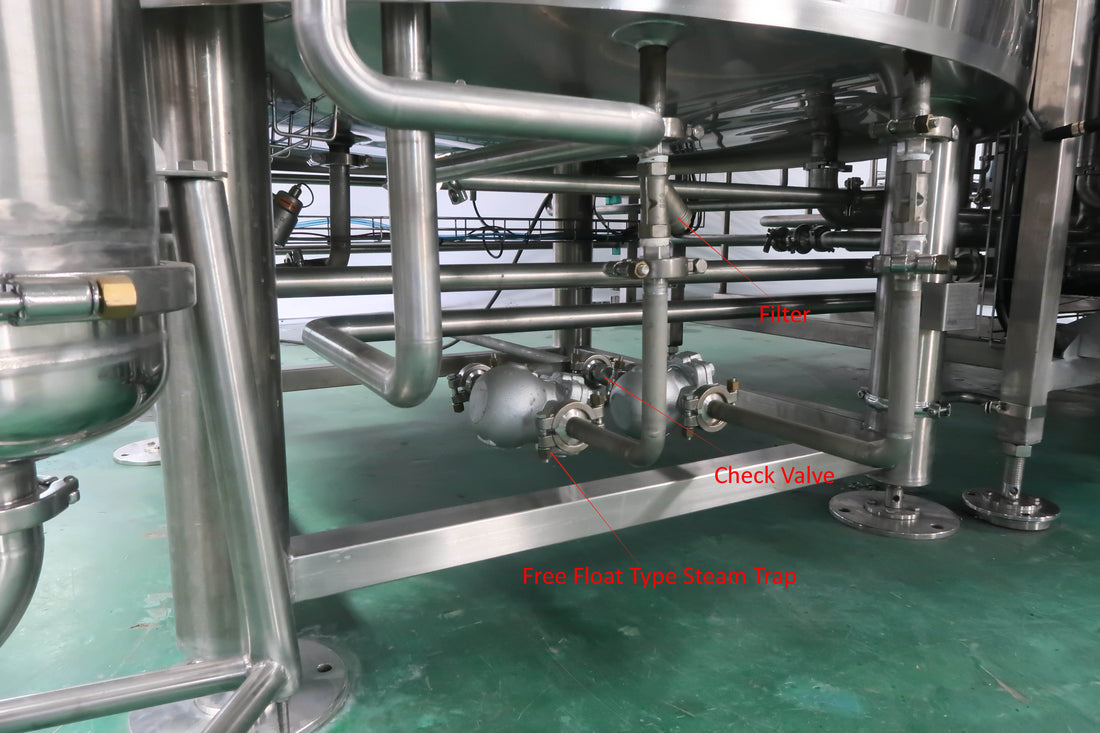Introduction: The Importance of Stainless Steel Steam Valves
Stainless steel steam valves are critical components in commercial brewing equipment, crucial for managing steam flow in production processes like mashing, boiling, cleaning, and sterilizing. Selecting high-quality valves ensures long-term reliability, reduces operating costs, and prevents common issues such as water hammer and flash steam.
This article explores various steam valve types, their roles in beer brewing equipment, and essential maintenance for maximizing quality and operational efficiency.
⸻
Why Steam Valves Are Essential in Brewing
Proper steam valves precisely control valve opening and closing, managing higher pressure steam critical for:
• Mashing: Optimizing temperature to activate enzymes.
• Boiling: Controlling heat exchanger efficiency, sterilizing wort, and extracting hops.
• Cleaning: Ensuring hygienic production by sanitizing equipment.
Quality valves reduce pressure drop and enhance consistent beer production.
⸻
Common Steam Valve Types for Breweries
Understanding different steam valve types ensures appropriate selection and long-term operational efficiency.
⸻
Pneumatic Angle Seat Valves
Design & Function:
Constructed from stainless steel, these valves minimize pressure drop and reduce water hammer with rapid opening and closing actions.
Applications in Breweries:
• Mash tun and wort boiler heating
• Automated cleaning-in-place (CIP) systems
• Fermentation temperature management
Advantages:
• Fast and reliable valve actuation
• Seamless integration with automated systems
• High durability for long-term use
Maintenance:
Regular inspections of valve seats and actuators ensure consistent operational quality.
⸻
Globe Valves
Function:
Globe valves offer precise flow control, optimizing steam flow and reducing operational costs.
Ideal Applications:
• Boil kettle steam regulation
• Heat exchanger temperature control
Valve Variants:
• Balanced globe valves for large-scale brewing operations
• Cage-guided valves suitable for compact setups in craft breweries
Installation Tips:
Install globe valves following the correct flow direction to avoid leaks and operational issues.
⸻
Steam Traps
Function:
Steam traps efficiently remove condensate, preventing flash steam loss and enhancing process improvement.
Commercial vs. Craft Brewery Use:
• Commercial Brewing: Thermodynamic traps suitable for higher pressure environments
• Craft Breweries: Float-thermostatic traps for lower pressures
Sanitary Design:
Stainless steel traps comply with food safety standards.
Maintenance:
Regular testing prevents energy losses and ensures optimal valve performance.
⸻
Check Valves
Types & Applications:
• Swing check valves are ideal for main steam lines in commercial brewing.
• Nozzle check valves are optimal for space-constrained craft breweries.
Importance:
Protects equipment from reverse steam flow, enhancing safety and operational efficiency.
Selection Advice:
Ensure valve specifications align with your brewery’s pressure and operational requirements.
⸻
Selecting the Best Steam Valves
Scale and Operational Needs:
Choose high-capacity valves for large breweries; compact solutions are preferable for craft breweries.
Compliance and Quality:
Ensure selected valves meet regulatory and hygiene standards, emphasizing stainless steel construction.
Reliability and Efficiency:
Opt for valves proven to withstand demanding brewing conditions to reduce long-term operating costs.
⸻
Redwood Brewery Valve Solutions
Why Choose Redwood:
Redwood offers specialized stainless steel pneumatic control valves rigorously tested for reliability and durability.
Customized Solutions:
Whether running a commercial brewing operation or a craft brewery, Redwood valves enhance steam system efficiency, batch consistency, and customer service quality.
Find our more about Redwood parts.
⸻
FAQs: Steam Valves for Breweries
Q1: Ideal valves for high-volume brewing?
A: Pneumatic angle seat valves and balanced globe valves.
Q2: How do steam traps enhance brewery efficiency?
A: By efficiently removing condensate and minimizing flash steam losses.
Q3: Are pneumatic valves suitable for multiple processes?
A: Yes, but always verify compatibility with brewing requirements.
Q4: Recommended valve maintenance intervals?
A: Typically every 6–12 months depending on usage.
Q5: Why are check valves essential?
A: They prevent damaging reverse flow, protecting equipment and beer quality.
Q6: Where to source brewery-specific valves?
A: Redwood offers tailored valve solutions for breweries of all scales.
⸻
Enhance Your Brewery’s Performance
Investing in quality stainless steel steam valves is essential for efficient production processes, lower operating costs, and sustained beer quality. Proper selection, installation, and maintenance are key to achieving ongoing process improvement and operational success.

